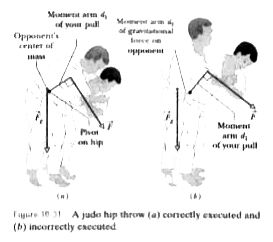To throw an 80 kg opponent with a basic judo hip throw, you intend to pull his uniform with a force →F and a moment arm d1 = 0.30 m from a pivot point on your right hip. You wish to rotate him about the pivot point with an angular acceleration α of −6.0rad/s2 - that is, with an angular acceleration that is clockwise in the figure. Assume that his rotational inertia I relative to the pivot point is 15kg⋅m2.
(a) What must the magnitude of →F be if, before you throw him, you benf your opponent forward to bring his center of mass to your hip?
(b) What must the magnitude of →F be if your opponent remains upright before you throw him, so that →Fg has a moment arm d2=0.12m?

(a) We can relate your pull →F on your opponent to the given angular acceleration α via Newton.s second law for rotation (τnet=Iα).
Calculations: As his feet leave the floor, we can assume that only three forces act on him: your pull →F, a force →N on him from you at the pivot point, and the gravitational force →Fg. To use τnet=Iα, we need the corresponding three torques, each about the pivot point.
From Eq. (τ=r⊥F), the torque due to your pull →F is equal to −d1F, where d1 is the moment arm r⊥ and the sign indicates the clockwise rotation this torque tends to cause. The torque due to →N is zero, because →N acts at the pivot point and thus has moment arm r⊥=0.
To evaluate the torque dur →Fg, we can assume that →Fg acts at your opponent.s center of mass. With the center of mass at the pivot point, →Fg has moment arm r⊥=0 and thus the torque dur to →Fg is zero. So, the only torque on your opponent is due to your pull →F, and we can write τnet=Iα as
−d1F=Iα
We then find
F=−Iαd1=−(15kg⋅m2)(−6.0rad/s2)0.30m
= 300 N.
(b) Because the moment arm for →Fg is no longer zero, the torque due to →Fg is now equal to d2mg and is positive because the torque attempts counterclockwise rotation.
Calculations: Now we write τnet=Iα as
−d1F+d2mg=Iα
F=−Iαd1+d2mgd1.
From (a), we know that the first term on the right is equal to 300 N. Substituting this and the given data, we have
F=300N+(0.12m)(80kg)(9.8m/s2)0.30m
= 613.6N≈610N.
Topper's Solved these Questions
- RIGID BODY DYNAMICS - IBOOK - RESNICK AND HALLIDAYCHAPTER - RIGID BODY DYNAMICS - IEXERCISE - CHECKPOINT
18 Videos
- RIGID BODY DYNAMICS - IBOOK - RESNICK AND HALLIDAYCHAPTER - RIGID BODY DYNAMICS - IEXERCISE - PROBLEMS
100 Videos
- RELATIVITYBOOK - RESNICK AND HALLIDAYCHAPTER - RELATIVITYEXERCISE - PRACTICE QUESTIONS (Integer Type)
5 Videos
- RIGID BODY DYNAMICS-IIBOOK - RESNICK AND HALLIDAYCHAPTER - RIGID BODY DYNAMICS-IIEXERCISE - PRACTICE QUESTIONS (Integer Type)
2 Videos
Similar Questions
Starting from rest a wheel rotates with uniform angular acceleration 2πrads−2 . After 4s ,if the angular acceleration ceases to act,its angular displacement in the next 4s is?
View SolutionStarting from rest a wheel rotates with uniform angular acceleration 2π rads−2.After 4s ,if the angular acceleration ceases to act,its angular displacement in the next 4s is?
View Solution
Knowledge Check
A circular disk of radius 2.0 m rotates, starting from rest, with a constant angular acceleration of 20.0rad/s2. What is the tangential acceleration of a point on the edge of the disk at the instant that its angular speed is 1.0 rev/s?
A40m/s2B110m/s2C79m/s2D120m/s2A body rotates about a fixed axis with an angular acceleration of 3rad/s2 The angle rotated by it during the time when its angular velocity increases frm 10 rad/s to 20 rad/s (in radian) is
A50B100C150D200A wheel has angular acceleration of 3.0rad/s2 and an initial angular speed of 2.00rad/s, In a time of 2 s it has rotated through an angle (in radian) of
A6B10C12D4
A body rotates about a fixed axis with an angular acceleration of 3rad/s2 . The angle rotated by it during the time when its angular velocity increases frm 10 rad/s to 20 rad/s (in radian) is
View SolutionA wheel has angular acceleration of 3.0rad/s2 and an initial angular speed of 2.00rad/s. In a time of 2s it has rotated through an angle (in radian) of
View SolutionA wheel has angular acceleration of 3.0rad/s2 and an initial angular speed of 2.00rad/s. In a time of 2s it has rotated through an angle (in radian) of
View SolutionA wheel has angular acceleration of 3.0rad/s2 and an initial angular speed of 2.00rad/s, In a time of 2 s it has rotated through an angle (in radian) of
View SolutionA wheel has angular acceleration of 3.0rad/s2 and an initial angular speed of 2.00rad/s. In a tine of 2s it has rotated through an angle (in radian) of
View Solution
